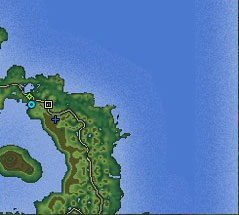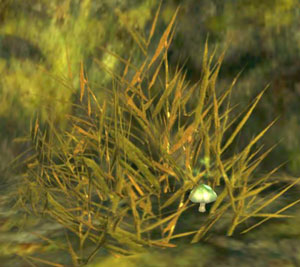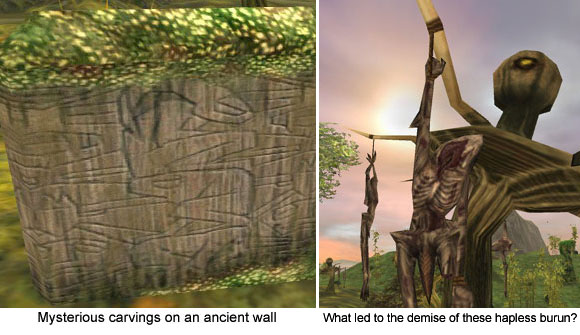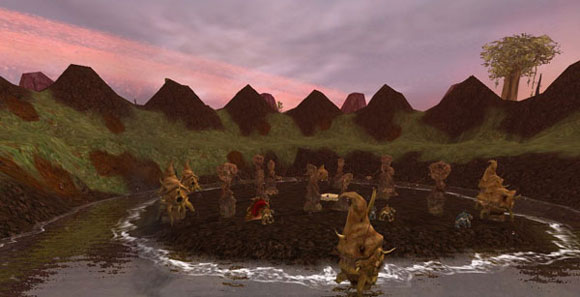


 Botany Guides
Botany Guides Kingdom Fungi
Kingdom Fungi
 Eco Alerts
Eco Alerts Fun Facts
Fun Facts Reedshark Hunter
Reedshark Hunter
 Desktop Dereth
Desktop Dereth Archaeology
Archaeology Lithomorphism
Lithomorphism TDC Explorer
TDC ExplorerJourney to the Farali Wildlife Preserve (cont.)  Before long we arrived at the portal to our next stop: Northeastern Farali. The cool humid air was suddenly replaced with warm tropical sunshine, the drab grays with brilliant yellows. Brogo immediately warned us to keep our distance from the burun gathered at the visitor's center. He explained that, when one lives in nature's backyard, close encounters with local wildlife are to be expected. These burun were, however, not native to the area, only recently having gathered at several outposts and even a nearby mine. Their migration is being studied with keen interest by a local team of naturalists, as wild animals usually avoid developed areas and these ones seem to congregate there specifically. Before long we arrived at the portal to our next stop: Northeastern Farali. The cool humid air was suddenly replaced with warm tropical sunshine, the drab grays with brilliant yellows. Brogo immediately warned us to keep our distance from the burun gathered at the visitor's center. He explained that, when one lives in nature's backyard, close encounters with local wildlife are to be expected. These burun were, however, not native to the area, only recently having gathered at several outposts and even a nearby mine. Their migration is being studied with keen interest by a local team of naturalists, as wild animals usually avoid developed areas and these ones seem to congregate there specifically.
Our tour continued southeast at a leisurely pace along the trail. At one point our guide grew quite excited, calling us all over to see what turned out to be a red dye plant. These are protected on the preserve, and it is illegal to harvest them, though this is another issue on which the indigenous crafters and the park rangers frequently come to blows over. "Renewable resources must be carefully managed, lest they be overused to the point no return." our guide explained. "We want future generations to be able to experience the beauty of red armor too."  We came across several colonies of mucor mushrooms, glowing here and there in the scrub brush. These are rather more common than the dye plants, but have userful medicinal properties. To help fund staffing and projects on the preserve, a set supply of mushrooms is regularly harvested from the Mucor Mushroom Grotto and exported. We came across several colonies of mucor mushrooms, glowing here and there in the scrub brush. These are rather more common than the dye plants, but have userful medicinal properties. To help fund staffing and projects on the preserve, a set supply of mushrooms is regularly harvested from the Mucor Mushroom Grotto and exported. These mushrooms are a prime example of why it is important to protect the diverse array of plantlife present in Farali. Who knows what other plants here may be one day discovered to contain other life-saving compounds? Around mid-day, we stopped to observe some of the more intriguing and mysterious evidence of civilization here in Farali. Crude but solidly constructed dwellings can be found throughout the northeastern region. These huts are in proximity to other constructed items including simple pottery containers, indicating an organized (though pre-iron era) civilization. It is suspected that these belong to the moarsman or burun, but which of these two is still unclear. The rather gruesome sight of dead burun hung from trees near the huts indicates either burun sacrificial ceremony or a display of victims on the part of the moarsmen. Whatever the reason, the disturbing sight does not compel one to stay in the area of this otherwise quaint village setting.  We left without incident, and continued our trek through the remainder of this enchanting land, stopping to wonder at the mysterious energy lattice mine (also burun-infested during our tour) and the geological effect it had on the immediate area. At this time I regret to report that our senior editor, Aken-Lotus, wandered too close to a boglurk armoredillo, and was tragically gored. It served as a sobering reminder of the park's minimum distance rules, but our tour was almost over anyway.  Our time in the Farali Preserve showed us that Farali is more than just a landscape; it is a priceless asset to the archaeological and pharmaceutical disciplines. For those who study flora and fauna, it is a singularity trove of the most diverse forms of life on the continent, and a legacy we must pass down intact to the next generation of newbs. There is much that has been learned about our world through study here, but only a fraction of what may yet be discovered.  |
||